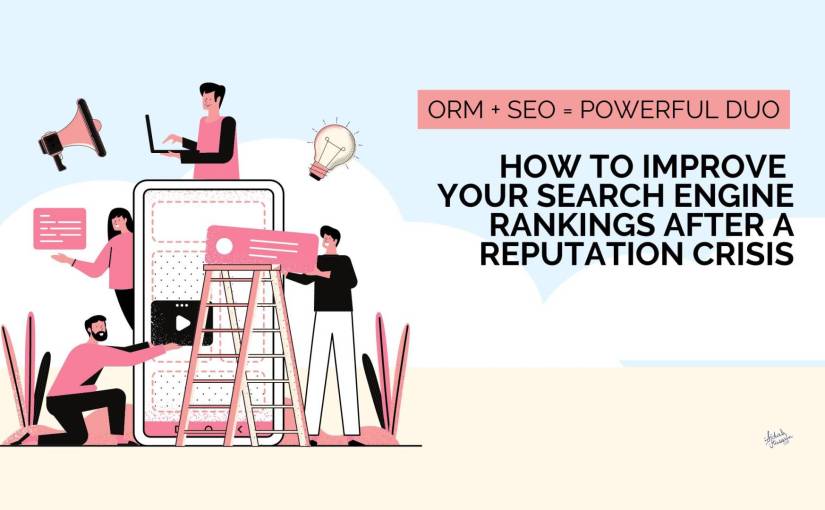Reputation is everything. In today’s digital world, your online reputation is just as important as your offline reputation. Online Reputation Management (ORM) is a big deal nowadays. As a business owner, you know that a negative online presence can cause major problems for your brand. If you’re experiencing a reputation crisis, it can be a stressful and overwhelming situation to deal with. But don’t worry — there is a way to get through it. Have you heard of SEO for reputation crisis?
ORM and SEO: How to Improve Your Search Engine Rankings After a Reputation Crisis
Dealing with a PR crisis isn’t easy — unless you proceed with the right approach. You can repair your tarnished reputation and regain control of your digital presence by using SEO for reputation crises. With some management, you can turn the tide in your favor.
I aim to give you ten actionable tips to improve your online reputation after a crisis. From creating a webpage to address the situation and responding constructively to negative reviews, there are ways to monitor your brand’s online reputation. You’ll utilize positive reviews and testimonials, and these tips will help you create a strong online presence and improve your SEO.
By taking proactive steps to enhance your brand’s reputation, you can increase your search engine rankings, boost your business, and prevent future reputation problems.
Let’s look at how these two can work together to help improve your search engine rankings after a reputation crisis. Let’s discuss how ORM and SEO can impact your business.
Ten Tips for Using SEO for Reputation Crisis
Step 1 – Create a Webpage to Address the Crisis
A web page that communicates your actions to correct the situation is essential for gaining public trust. To ensure that customers can easily find and access your site, SEO techniques — such as keyword targeting and strategic linking, helps customers find this page.
Step 2 – Utilize Positive Content Marketing Tactics
Leveraging the power of blogging and press releases is a great way to enhance your company’s reputation. Publishing new, relevant content on your website — from blog articles and news updates to executive statements and analysis pieces — allows you to produce more positive search engine results that can provide a balance for any negative content about your company online.
A proactive approach will help to reduce the prevalence of damaging articles and build brand recognition in your industry, ultimately bolstering the public perception of who you are as a business.
Best of all, with regular maintenance and upkeep of your original content, you can achieve sustained visibility over time in an impactful and cost-effective manner.
Step 3 – Respond Constructively to Negative Reviews
Responding constructively to any negative reviews or comments you come across is a great way to show your followers that their opinion matters. This lets them know that their feedback is not being taken lightly and that their voice has been heard.
In essence, showing respect to negative reviews can work in your favor, as followers will appreciate your effort in tackling their issues despite having an unfavorable opinion of your product/service.
If necessary, don’t be afraid to apologize, and make sure to thank them for providing constructive criticism. This shows appreciation to the person giving feedback and provides you with valuable insight into the techniques that worked.
Step 4 – Incorporate Social Media into the ORM strategy
To stay competitive in the digital world, it is essential to incorporate social media into your online reputation management strategy. Not only should you be monitoring what users say on social platforms, but you should also be engaging with customers and responding promptly to any complaints or concerns they may have voiced. This will help you maintain a positive online profile and build trust with your online community.
Step 5 – Devise a Crisis Communication Plan
Developing a crisis communications plan is essential for any business that values its reputation. Every organization should have an actionable plan which explains how they will respond to negative publicity.
Crafting a comprehensive plan ahead of time can keep the organization calm, composed, and organized during a public relations crisis and ensure that accurate information reaches the right audiences in a timely fashion. A staff member should also be designated as an official spokesperson to provide statements on behalf of all stakeholders involved.
Step 6 – Analyze Your Brand’s Online Reputation
It is important to stay on top of your online presence by monitoring what people say about your brand. This can help you identify any potential issues and keep track of the positive aspects of your reputation.
You can use a variety of tools, such as Google Alerts, Hootsuite, or Social Mention, to track what people are saying about your brand online. This will allow you to stay informed and respond quickly and effectively when needed.
In addition, you should also make an effort to constantly monitor your accounts for any suspicious activity or fraudulent reviews that could damage your reputation. If you find anything, it’s important to take action quickly and address the issue before it gets out of hand.
Step 7 – Reach Out to Influencers
Engaging with influencers is a great way to increase your brand’s visibility and reach more potential customers. By reaching out to influencers with a large following, you can leverage their influence and credibility to build trust in your brand.
Reaching out to influencers doesn’t have to be complicated or time-consuming. You can start by connecting with them on social media, emailing them to introduce your brand or its products, and inviting them to collaborate with you. Collaboration could include hosting giveaways, creating content together, or offering discounts and special offers.
These efforts will help you increase your online presence, create positive word of mouth, and boost your online reputation. Connecting with the right influencers can reach a larger audience and keep your brand’s image positive.
Step 8 – Utilize Positive Testimonials and Reviews
Positive customer reviews are among the best ways to build trust with potential customers and improve your online reputation. Encourage your customers to leave reviews on platforms like Google, Yelp, and Facebook. You should also take the time to respond to any negative reviews or feedback professionally and courteously.
Testimonials are another great way to boost your online reputation and encourage potential customers to purchase from you. Reach out to satisfied customers who have used your products or services and ask them to write a testimonial. This can be done through email, social media, or even in person. You can then use these reviews and testimonials on your website and other platforms to show potential customers why they should choose you over the competition.
Step 9 – Manage Your Online Presence
It’s important to create a plan to manage your online presence and stay on top of what people say about your brand. You can set up daily or weekly checks to review all the platforms where your brand is mentioned, such as social media and review sites. Managing your online presence will help you stay on top of any negative comments and address them quickly.
You should also consider setting up alerts or notifications for when your brand is mentioned anywhere online. This way, you can respond to feedback quickly and answer questions or address concerns before they become an issue. When you manage your online reputation and respond to alerts and notifications, it will help you build trust with customers and give them a positive experience with your brand.
You will want to stay on top of negative comments, maintain control over your brand’s perception, and protect your SEO from a Reputation Crisis. By focusing on creating content that adds value, engaging with existing customers, and utilizing positive reviews and testimonials, you can create a strong online presence and improve your SEO for the Reputation Crisis. With the right strategies in place, you can quickly turn around any negative reviews and take control of your online reputation.
Step 10 – Monitor Progress
The last step in improving your online reputation is monitoring progress. It’s important to track any changes over time. And measure how effective your strategies are at improving your search engine rankings.
You can use the following metrics to gauge the success of your efforts.
- website traffic
- customer reviews
- social media engagement
- brand mentions
Pay close attention to these metrics. Making adjustments where necessary. Metrics will help you can maximize your SEO for Reputation Crisis and ensure that your online reputation is as strong as possible. With the right strategies in place, you can quickly turn around any negative reviews. Meaning — you take control of your online reputation.
You can create a strong online presence and improve your SEO for the Reputation Crisis by:
- focusing on creating content that adds value
- engaging with existing customers
- utilizing positive reviews and testimonials
With the right strategies in place, combined with regular monitoring of progress, you can protect your online reputation and maximize your SEO for Reputation Crisis.
Wrapping Up
Reputation management is crucial for businesses. It’s important to have a plan in place if you experience a crisis. ORM isn’t just about putting out fires. By taking proactive steps to improve your online presence, you can increase your search engine rankings and prevent future reputation problems. Following the tips I’ve outlined above, you can improve your online reputation today and protect your business from future damage.
Featured Image Credit: Provided by the Author; Thank you!



